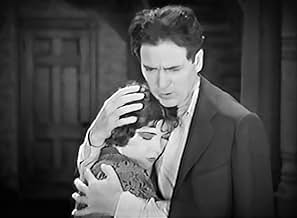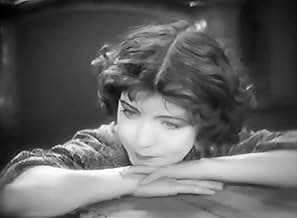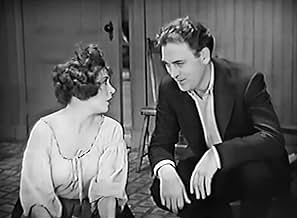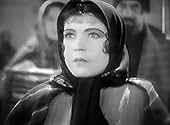Ajouter une intrigue dans votre langueA WWI vet takes on the KKK when he loses his wife to a womanizing Klansman.A WWI vet takes on the KKK when he loses his wife to a womanizing Klansman.A WWI vet takes on the KKK when he loses his wife to a womanizing Klansman.
- Réalisation
- Scénario
- Casting principal
- Récompenses
- 4 victoires au total
Symona Boniface
- Woman at Welcome-Home Party
- (non crédité)
Delmer Daves
- Undetermined Role
- (non crédité)
Christian J. Frank
- Wife Beater
- (non crédité)
Herman J. Mankiewicz
- Newspaperman
- (non crédité)
Broderick O'Farrell
- Poker Player on Train
- (non crédité)
Frederick Sullivan
- Poker Player with Rabbit's Foot
- (non crédité)
Will Walling
- Uncle Billy - Townsman
- (non crédité)
Avis à la une
A soldier (Thomas Meighan) returns from the war to find that his secret marriage has been annulled and his sweetheart has re-married. That doesn't stop the ex-wife (Evelyn Brent) from directing her attentions toward him while her current husband sees other women. But these associations with a married woman get the soldier in trouble with the local Ku Klux-type Order.
THE MATING CALL (1928) really is a solid silent film. I watched it on a whim and was pleasantly surprised. TCM host Robert Osborne assured viewers that James Cruze was a top-tier director of the silent era, and his direction here is solid. This is one of the rare Howard Hughes- produced silent films that had been considered lost before turning up in Hughes's private collection in recent years. The restoration looks great, the photography crisp and clear.
The lovely Evelyn Brent is terrific as the town belle turned vamp. What a screen presence! I recall seeing her with William Powell in HIGH PRESSURE (1932), but she really makes an impression with this sexy, seductive performance. She has a real charisma on screen. There's also a great scene where a bitter Meighan, unmoved by her advances, forcibly removes Brent from his home as she battles back.
Renée Adorée is very cute as an immigrant girl and reluctant bride. Her sweet and innocent character is in stark contrast to Brent's character and gives the film a love story. There's a scandalous skinny dipping scene, but the distant nudity is innocuous enough.
The masked Order pose a dangerous threat and add a darker drama to the tangled web of small-town romance. The performances and the underlying darkness (including an eerie riverside discovery) raise this movie above other, more soapy melodramas and make THE MATING CALL one to check out.
THE MATING CALL (1928) really is a solid silent film. I watched it on a whim and was pleasantly surprised. TCM host Robert Osborne assured viewers that James Cruze was a top-tier director of the silent era, and his direction here is solid. This is one of the rare Howard Hughes- produced silent films that had been considered lost before turning up in Hughes's private collection in recent years. The restoration looks great, the photography crisp and clear.
The lovely Evelyn Brent is terrific as the town belle turned vamp. What a screen presence! I recall seeing her with William Powell in HIGH PRESSURE (1932), but she really makes an impression with this sexy, seductive performance. She has a real charisma on screen. There's also a great scene where a bitter Meighan, unmoved by her advances, forcibly removes Brent from his home as she battles back.
Renée Adorée is very cute as an immigrant girl and reluctant bride. Her sweet and innocent character is in stark contrast to Brent's character and gives the film a love story. There's a scandalous skinny dipping scene, but the distant nudity is innocuous enough.
The masked Order pose a dangerous threat and add a darker drama to the tangled web of small-town romance. The performances and the underlying darkness (including an eerie riverside discovery) raise this movie above other, more soapy melodramas and make THE MATING CALL one to check out.
This movie is a unique glimpse into the culture of the period. One outstanding item is the depiction of a clan-type organization who acts more as a community secret police (seriously flawed in their self-righteous and heavy handed rule) in general than as a specifically racist group. I had always heard about this being their main historic role because in many parts of the country where these groups existed, there were simply not sufficient numbers of minorities around to pick on and by their nature these groups had to pick on someone.
The film's treatment of sexuality seems far more erotic just in the suggestion of nudity and intimate touching than today's practice of "anything goes" sexual contact and the full nudity of multi-millionaire, artificially enhanced actors. I know old-timers and conservatives have been saying this for years but seeing this movie proves the point.
I was so interested in the acting that I really didn't care about the plot. Also, the film is so well restored that it is almost in 3-D.
The film's treatment of sexuality seems far more erotic just in the suggestion of nudity and intimate touching than today's practice of "anything goes" sexual contact and the full nudity of multi-millionaire, artificially enhanced actors. I know old-timers and conservatives have been saying this for years but seeing this movie proves the point.
I was so interested in the acting that I really didn't care about the plot. Also, the film is so well restored that it is almost in 3-D.
Evelyn Brent was a marvelous and smolderingly beautiful actress of the silent screen who made a staggering number of films from 1915 to the 1940s. This film is worth seeing for her alone. Her performance as a small town vamp holds up completely by 21st century standards and that's not common. James Cruze has a good reputation and it's easy to see why from this film. The action moves briskly, scenes do not linger unnecessarily but only when emphasis is needed. Intimate moments are handled skillfully and believably. Set pieces are convincing. Here is a movie where someone scrubs a floor and really does the kind of work you have to do to scrub a floor, though I was a bit surprised to see Renee Adoree sloshing the entire contents of a water basin directly onto the linoleum during the rinse phase. It really annoyed me that she became distracted and let the puddle (or lake, really) remain and if I had been Thomas Meighan's character I would have been much more upset than he seemed to be. Meighan seems a bit wooden and but I think he was trying to play a simple farming man with a tough exterior.
I am not the only one who noticed that the women's costumes and hair styles (not to mention the automobiles) were way too modern for the time period presented, 1919. Cloche hats did not make their appearance that soon after World War I. Another element that cannot be ignored are the palm trees in this town, which suggest that the action takes place in southern California, but when the Meighan character decides to find an off-the-boat immigrant to marry, he travels to Ellis Island, thousands of miles to the east, even though he is a struggling farmer. Then presto! He's back in Southern California with the newfound bride and her parents who look no worse for wear than if they had been trucked in from a neighboring county. To be fair, these jolting progressions seem to be standard fare in early films and are also used quite a bit in early talkies. But for us sophisticated 21st century viewers they do stretch credulity and get in the way of our serious involvement in the proceedings.
One strand of the plot involves a KKK-like organization called "The Order." But this is not the KKK we're all familiar with this group of hooded vigilantes rounds up local men who are perceived to be less than honorable to the town's womenfolk and whips them on posts until they repent and agree to behave in a more chivalrous manner! To contemporary audiences this comes across as a very funny joke.
I am not the only one who noticed that the women's costumes and hair styles (not to mention the automobiles) were way too modern for the time period presented, 1919. Cloche hats did not make their appearance that soon after World War I. Another element that cannot be ignored are the palm trees in this town, which suggest that the action takes place in southern California, but when the Meighan character decides to find an off-the-boat immigrant to marry, he travels to Ellis Island, thousands of miles to the east, even though he is a struggling farmer. Then presto! He's back in Southern California with the newfound bride and her parents who look no worse for wear than if they had been trucked in from a neighboring county. To be fair, these jolting progressions seem to be standard fare in early films and are also used quite a bit in early talkies. But for us sophisticated 21st century viewers they do stretch credulity and get in the way of our serious involvement in the proceedings.
One strand of the plot involves a KKK-like organization called "The Order." But this is not the KKK we're all familiar with this group of hooded vigilantes rounds up local men who are perceived to be less than honorable to the town's womenfolk and whips them on posts until they repent and agree to behave in a more chivalrous manner! To contemporary audiences this comes across as a very funny joke.
Evelyn Brent's depiction of Rose Henderson truly makes me wonder just how
much better films of the thirties, forties, and fifties to mid sixties would have been had not censorship seized control of Amercan cinematography in the early
1930's. Instead of a scene showing Rose and her wealthy husband Lon each in a twin bed separated by a nightstand, The Mating Call has Rose calling on her
ex-husband, Leslie, who has just returned from WWI to find out his marriage to underage Rose was annulled by her parents when he was serving in France.
Rose has no love for her husband, Lon, as he is having an affair with a much
younger woman, and despite Leslie's not wanting to see her again, Rose
repeatedly attempts to seduce him - finally tricking Leslie into joining her in his bedroom after she has begun to disrobe. If TCM runs it again, check it out. It's nice to know that pre-production code movies actually depicted some of the
interesting realities of life that censors wouldn't allow.
much better films of the thirties, forties, and fifties to mid sixties would have been had not censorship seized control of Amercan cinematography in the early
1930's. Instead of a scene showing Rose and her wealthy husband Lon each in a twin bed separated by a nightstand, The Mating Call has Rose calling on her
ex-husband, Leslie, who has just returned from WWI to find out his marriage to underage Rose was annulled by her parents when he was serving in France.
Rose has no love for her husband, Lon, as he is having an affair with a much
younger woman, and despite Leslie's not wanting to see her again, Rose
repeatedly attempts to seduce him - finally tricking Leslie into joining her in his bedroom after she has begun to disrobe. If TCM runs it again, check it out. It's nice to know that pre-production code movies actually depicted some of the
interesting realities of life that censors wouldn't allow.
THE MATING CALL was shown on TCM on Dec. 15, 2004, marking its apparent first screening since 1928. The silent film is something of a morality play, complete with a returning soldier who has lost his wife (to an adulterer); a morals police force, the Order, in dark cloth hoods (except for the leader, who wears satin); one woman drenched by a bucket of water and another caught skinny-dipping; and some provocative eyebrow acting. Evelyn Brent radiates sex as Rose, while Thomas Meighan seems mostly confused as the farmer who needs a replacement woman -- and goes to Ellis Island to get one! THE MATING CALL, directed by James Cruze (I COVER THE WATERFRONT), ably entertains while carrying a rather more serious theme on hypocrisy.
Le saviez-vous
- AnecdotesLong thought to be lost, a print was discovered in the Howard Hughes collection at the University of Nevada, Las Vegas.
- GaffesAlthough the story takes place immediately after World War I (1918-1919), all of Evelyn Brent's and Helen Foster's clothes are strictly in the 1928 short skirt mode, completely out of place in the time frame of the story.
- Citations
Poker Player: Major Hatten seems to be suffering from shell shock.
Hatten's Best Man: Worse than that! He's in love - with his own wife.
- Versions alternativesIn 2004, the University of Nevada Las Vegas and Flicker Alley, LLC copyrighted a digitally restored version with a new orchestral score composed, arranged and conducted by Robert Israel. It was produced by Jeffery Masino and runs 72 minutes.
- ConnexionsReferences The Sky Rider (1928)
Meilleurs choix
Connectez-vous pour évaluer et suivre la liste de favoris afin de recevoir des recommandations personnalisées
Détails
- Date de sortie
- Pays d’origine
- Langues
- Aussi connu sous le nom de
- The Mating Call
- Lieux de tournage
- General Service Studios - 1040 N. Las Palmas, Hollywood, Los Angeles, Californie, États-Unis(studio - known as Metropolitan Studios at the time)
- Société de production
- Voir plus de crédits d'entreprise sur IMDbPro
Box-office
- Budget
- 400 000 $US (estimé)
- Durée
- 1h 12min(72 min)
- Couleur
- Mixage
- Rapport de forme
- 1.33 : 1
Contribuer à cette page
Suggérer une modification ou ajouter du contenu manquant






















